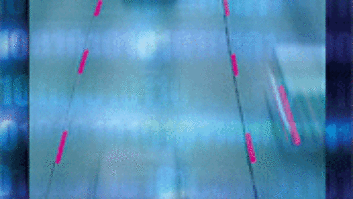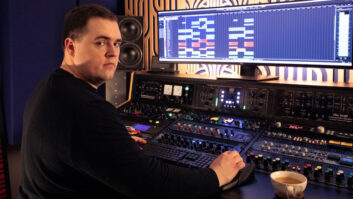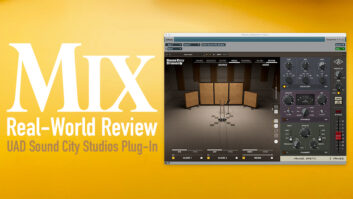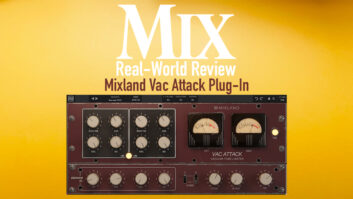Last month I talked about some recent additions to the MIDI
Specification that will help to keep it alive and relevant in the 21st
century, and about the problems of running MIDI over USB, the
ubiquitous connection scheme that’s been replacing serial, parallel and
SCSI cables over the last couple of years. If you missed that column,
you can read it
here, or here.
This month, I’ll look at how MIDI relates to IEEE-1394, the new
communications protocol that’s worming its way not only into the
computer world, but also into everything from video cameras to
dishwashers to cars.
IEEE-1394, as everybody knows by now, was developed by Apple back in
1995 and dubbed FireWire. It was adopted by the Standards Association
of the Institute of Electrical and Electronics Engineers, and thus
entered the public sphere with a boring name. (Apple will license its
name and logo to anyone for free, but Sony calls it
“iLink,” and other companies use their own monikers.)
1394 is a serial protocol that runs at speeds from 100 to 400
megabits/second, and work is currently under way (and expected to be
completed in the first half of 2001) to increase the top speed to as
high as 3.2 Gigabits/sec. Even better, it can support multiple data
streams simultaneously, bidirectionally and running at different clock
rates—so you can be sending and receiving MP3 audio, 96kHz audio,
compressed and uncompressed video, and MIDI, and at the same time
scanning stuff into PhotoShop, all over the same 1394 cable, without
any of them getting into each other’s way.
Unlike MIDI, 1394 is not free for any manufacturer to use, but the
licensing terms are pretty painless: There’s no association to join or
dues to pay, and no requirement that Apple or anyone else must certify
that a 1394 device works the way it’s supposed to. There is a charge of
25 cents per device that reaches the marketplace. (But for a handful of
large companies, like Sony, Toshiba, Canon and Panasonic, that have
joined Apple’s patent pool, that charge is waived.) Originally, Apple
wanted to charge much more, but in the face of competition from Intel’s
USB 2.0, according to some sources in the industry, they backed down.
It was a good political move, to say the least.
Unlike USB, which was really created to replace mouse and modem
ports, 1394 was designed from the ground up for media applications.
Already, as we saw last month, USB is being pushed to its limits, and
even consumers are catching on: As one source told me, USB-powered
speakers are “failing miserably” in the marketplace. Even
in the simplest of environments, USB systems can easily get
overloaded—I spent a couple of hours with a client last month
beating my head against a wall trying to figure out how to get her new
iMac-based MIDI system working, until I realized that the fancy USB hub
she had couldn’t supply enough power to run her scanner, her fax modem
and her MIDI interface at the same time!
Also, unlike USB, MIDI events sent over a 1394 cable have a
guaranteed time of arrival, so the stopgap measures to make up for
USB’s problems and prevent MIDI timing slop and jitter, like Mark of
the Unicorn’s “MIDI Time Stamping” and other proprietary
schemes, are not necessary. According to Jim Wright of IBM, chairman of
the working group of the MIDI Manufacturers Association that’s dealing
with advanced data transport, MIDI and audio data over 1394 are tightly
coupled when it comes to timing so that you can get perfect
synchronization between them, at least with a reasonable number of
audio streams.
Trying to get manufacturers to understand this has not been easy.
According to one company, “We’re hitting a brick-wall with the
multimedia giants. They don’t understand anything less than a
millisecond—or even a frame.” I just finished working on a
DV/FireWire-based film in which getting the audio and video to stay in
sync has been a constant struggle. But, hopefully, this problem won’t
last as more developers get involved.
One of 1394’s chief advantages to audio users is that devices using
the protocol are “hot-swappable”; unlike with SCSI (but
like USB), you can plug and unplug devices without turning anything
off—although personally, I’ve been hot-swapping SCSI cables for
years and never had a single equipment failure. (But I live
dangerously.) So when you need to find that old file on a Zip disk but
you forgot to connect the drive, or you want to add a new
FireWire-based signal processor to your rig, you don’t have to shut the
whole system down. (I have encountered one area, however, where
hot-swapping 1394 equipment didn’t work: In the project I just
finished, using a popular PC-based editing system, we discovered that
an external video deck won’t be recognized unless it’s plugged in at
the time you power up the system. Well, nobody’s perfect.)
1394 cables are inexpensive, in that they consist of little more
than a couple of twisted copper pairs, and yet the amount of data that
can go down them is staggering. It may be a while before we find out
what FireWire’s limits are in terms of simultaneous audio and MIDI
streams. But implementing it in hardware is not quite so cheap: You can
find FireWire PCI cards for under $100, but one manufacturer says that
putting 1394 into a typical audio processor, mixer or synthesizer would
raise the cost by about $100, compared to a MIDI or even a USB
port.
“It’s not even on most motherboard makers’ radar,”
according to one synthesizer manufacturer. But Apple (of course)
already has it on its desktop models and some iMacs, and Sony has put
it on its Vaio model PCs so that users can hook up their (presumably
Sony) video cameras directly into the computer. And, as we’ve seen many
times, once a new technological fad takes off—and 1394 is doing
just that, as it will soon be showing up in everything from home
appliances and security systems to factory automation to automobile
“entertainment systems” (what, dodging SUVs and talking on
your cell phone isn’t entertaining enough?)—everyone wants in on
it, and the price nosedives.
The MIDI Manufacturers Association has adopted a
“MIDI-over-1394” specification, which, in turn, has been
ratified by the 1394 Trade Association, so there shouldn’t be any
confusion about how MIDI is going to travel over a 1394 cable or how it
will get along with its cable-mates. (The MMA’s early participation in
the 1394 development process is one major reason why MIDI performance
over 1394 is not going to be the problem that it is over USB.) The
MMA’s spec has also been incorporated into mLAN, Yamaha’s
nonproprietary extension to the 1394 protocol, which deals specifically
with audio issues and is the first serious attempt to get an audio
“layer” onto the FireWire spec. mLAN is now, or will soon
be, available on a number of Yamaha and Korg products, and it will be
interesting to see how the MIDI implementation of these products
works.
There’s no reason why a 1394 cable can’t carry thousands of MIDI
channels, with or without audio. And this opens up a door to something
that not long ago we dared not speak its name: a MIDI 2.0
specification. The original MIDI spec allowed only a very limited
number of channels on a cable, mandated a data rate that by today’s
standards is ridiculously slow and only permitted data to flow in one
direction. Although it has expanded radically over the years, it has
always had to work within those limitations. If the spec could be
rewritten with 1394 in mind, then the potential improvements are
staggering.
Of course, you could have 1,000 or 5,000 MIDI channels, but you
could also have 1,000 controllers per channel and new types of
controllers that are much more data-intensive than the current 7-bit
ones, like, for example, 1 million levels of pitch bend, covering 10
octaves. The old MIDI spec allows for 14-bit controllers, but no one
uses them because of fear, ignorance or simply economy. When bandwidth
limitations go away, these could become commonplace. The speed of the
MIDI line could also be increased by a factor of 10 or 1,000 or even
made variable to suit different needs. And, instead of a dozen cables
emerging from a multiport interface to power a dozen individual
devices, there wouldn’t even be a need for a specific “MIDI
interface” anymore. A production system would simply consist of a
daisy-chain of hot-swappable MIDI (as well as audio and video) devices
that connect directly to the master computer or directly to each other
without a computer in the middle. (Try that with USB!)
And, under a new high-speed spec, a MIDI system could for the first
time be truly bidirectional. Musical devices could query and
communicate with each other and with the host computer
automatically—no more dealing with OMS or MediaPlayer setup
files, because the system would reconfigure itself (and reconfigure
your software, too) automatically every time you added or took away a
piece of gear. In Jim Wright’s words, “MIDI 2 would mean never
having to read Sysex again.”
MIDI 2.0 would, of necessity, be backward-compatible with MIDI
1.0—meaning, older devices would be accommodated, both physically
and in terms of the data stream—and converters and breakout boxes
with 1394 inputs and MIDI ins and outs would be hot-ticket items for
some time to come. And the recent (well, almost two years old now)
addition to the MIDI spec that allows multiple devices to be addressed
in a Standard MIDI File would become the rule, rather than the
exception. With hundreds of devices attached to a front end, the idea
of limiting file exchanges between platforms that are limited to 16
channels will seem positively quaint, if not downright dumb.
Wright says he would be in favor of a MIDI 2.0 spec that represents
a “broadbased effort, one which will involve manufacturers,
musicians, academics and other key stakeholders.” He favors an
“‘open-spec effort, similar to Linux’s open-source.”
It’s a fine idea, worthy of a community that started out by an
unprecedented show of cooperation among competitors and has continued
to grow in that spirit.
Before I close this discussion on the future of MIDI, I have to
mention a sour note. It’s relatively old news, but it’s something that
has made a lot of people in the MIDI world, including me, very angry
and continues to do so. While the development of MIDI demonstrated how
cooperation between companies, and the executives, engineers and
marketers within those companies, could create a multibillion-dollar
industry, this item demonstrates the opposite: What happens when a
company that doesn’t give a rodent’s patootie about a significant
aspect of the music-production community—its developers or its
customers—gets its corporate fingers into it?
One year after Gibson president Henry Juszkiewicz publicly
apologized for “the lack of information on the current situation
at Opcode and the current short fall [sic] in tech support,” and
stated, “It is our sincere intention to improve this situation as
soon as we are able,” absolutely nothing has happened. Pleadings,
petitions and, reportedly, offers of all kinds notwithstanding, Opcode
Systems, which had the first working MIDI sequencing program on the
Macintosh, introduced the first and still the most-used multiple-device
driver software for the Mac, created the first MIDI-plus-audio
sequencer on the Mac and whose software had fervent adherents at all
levels of the industry all over the world—and taken over by
Gibson in 1998—is dead.
There is still a Web site where you can download 18-month-old
versions of Vision and Studio Vision (www.opcode.com, but not just
“opcode.com,” which takes you to Gibson’s front page), and
Gibson will be happy to take your Mastercard number, but it’s not at
all a sure bet that the software you get will work for more than 30
days. That’s when you will need to enter a “response” to
the company’s copy-protection “challenge,” because no one
seems to be home at “Opcode” to send the responses. The
single individual doing tech support for the products has had his or
her e-mail account shut off.
OMS, its device driver software, despite a huge movement that has
included thousands of individuals and hundreds of companies, like
Digidesign, Emagic and even NBC, to get Gibson to place it in the
public domain, remains in limbo. According to one former employee,
“They could regain an enormous amount of goodwill by releasing
the source code in such a way that it can be maintained. It could be
open-sourced, given to Apple or the MMA, or to a developer willing to
make a commitment to keep it an open standard that benefits all of the
platforms’ developers and users.” It was a no-lose situation for
Opcode. It would have cost Juszkiewicz nothing—OMS hadn’t been
generating revenue for years—and it would have made him a hero
(well, at least he’d no longer be Cruella DeVille) among the computer
music community. But it ain’t happened yet, and time is running
out.
If the company felt that it really needed to somehow get its
investment back, then a year ago there were plenty of people willing to
buy pieces of Opcode’s other technology. But the longer Gibson waits
(and the real story behind the legal wranglings in this case is even
uglier than the Florida ballot counting debacle), the less that
technology is worth. By now I’d bet that most of it would barely be
worth putting on Ebay. (Although the Audio-to-MIDI and vice versa
feature is still pretty damn cool.)
I’ve been using Vision and its variants for almost 10 years, and I
plan to keep using it, tech support or no tech support, until either I
am forced to go to a system that simply won’t run it (I’m told it
behaves itself under OS 9, but under OS X, all bets are off) or I need
new features that other programs offer that will never find their way
into this moribund program. It will be the third MIDI-sequencing
program I will have had shot out from under me, because, once again,
stupid business decisions have forced a perfectly good musical tool to
disappear from the face of the Earth.
Opcode was just the latest in a series of synthesis and computer
technologies that Gibson has destroyed—Oberheim and Zeta Systems
being the two best-known. Why they do this is anybody’s guess; perhaps
they think that somehow it will help guitar sales. If so, then maybe
they should have a little chat with Yamaha—one of the most
successful guitar makers in the world—about being able to have it
both ways. Whatever the reason, shame on Gibson. It makes me even more
eager to find some other manufacturer who has figured out how to make a
really good clone of an ES-335.
“Insider Audio” columnist Paul D. Lehrman doesn’t
plan on missing Sysex one bit, so to speak. Visit his home page at www.paul-lehrman.com







